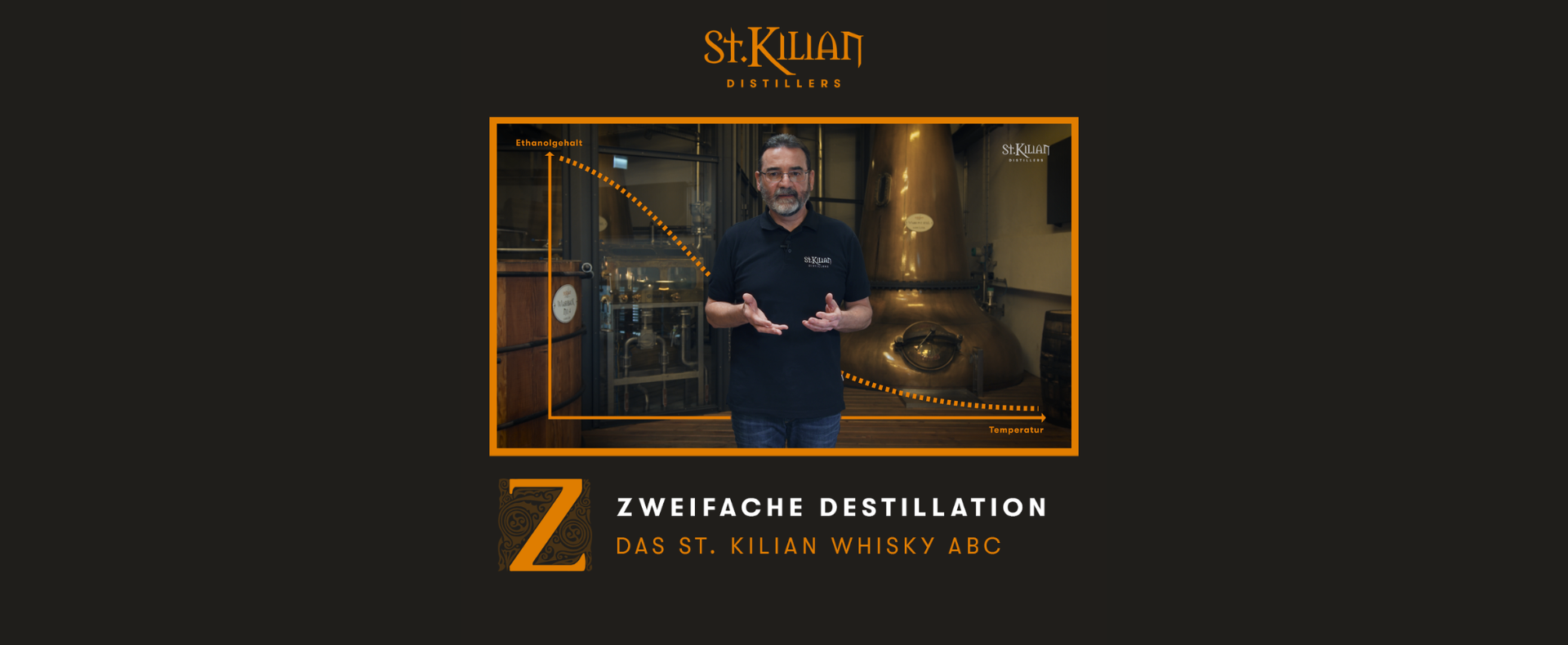Z - like double distillation

What is distillation?
Distillation is a physical process for separating liquids that have different boiling points. The principle is based on the fact that at a given temperature, the liquid with the lower boiling point (e.g. ethanol at 78.3°C) evaporates first, while the liquid with the higher boiling point (e.g. water at 100°C) remains behind.
How often must distillation take place?
In the production of malt whisky, the beer-like, slightly alcoholic liquid from the fermentation (= "wash") is distilled in the copper stills (pot stills). At St. Kilian, as in the malt distilleries in Scotland, distillation takes place discontinuously, i.e. in the so-called batch process. In this process, distillation takes place at least twice. Some Scottish distilleries (e.g. Auchentoshan) even carry out this process three times.
Why is distilled twice?
The reason for this lies in the laws of thermodynamics. The reason is quite simply that water and ethanol do not form an ideal mixture. This is because it is a non-ideal mixture of liquids. This means that the mixture behaves differently than the respective pure substances (in our case water and ethanol, the small amounts of flavoring substances are not taken into account) alone. This also affects the distillation behavior of the mixture, because the vapor-liquid equilibria of water and ethanol also show a non-ideal behavior.
How does this less than ideal mixing behavior play out in practice?
When the wash is heated with an approximate alcohol content of 7-8 percent by volume (v/v) ethanol, this mixture boils at about 90°C. Since ethanol is more volatile than water and boils about 20°C lower at 78.3°C, it accumulates in the vapor phase. Thus, while the mixture has an ethanol content of 7-8% by volume in the liquid phase, this is already about 45% by volume in the vapor phase.
How does the ethanol content change during the first distillation?
Due to the volatility, ethanol accumulates in the vapor phase. This distillation vapor is condensed in the condenser and thus removed from the system in the still. This means that the amount of ethanol in the initial solution decreases during distillation, as more ethanol evaporates than water. Consequently, the liquid mixture in the still has a lower and lower percentage of ethanol, boils higher and higher, and the amount of ethanol in the vapor becomes less and less. At the end of the first distillation, a total distillate (= "low wines") of about 20-25% ethanol by volume on average is thus obtained.
Why is a second distillation necessary?
According to EU spirits regulations, a whiskey must have a minimum alcohol content of 40% by volume. Since, at 20-25% by volume after the first distillation, we are still a long way from that, a second distillation is required. The still for the second distillation is called a Spirit Still.
What happens before the second distillation?
The separately collected pre and post run of the preceding second distillation, which still contain ethanol, is added to the low wines obtained after the first distillation. In the process, the ethanol content increases from an initial 20-25% by volume to around 25-28% by volume.
How does the second distillation proceed?
The mixture of low wines and pre- and post-run with an ethanol content of about 25-28% by volume is now heated in the Spirit Still. It boils at a temperature of about 86°C and results in an enrichment of ethanol in the vapor phase of initially about 75-80% by volume. Initially, the highly alcoholic and sometimes toxic preliminary run appears in the distillate, which is separated from the desired middle run, the heart. The alcoholic middle run, which is enriched with desired aroma substances, is collected up to an alcohol content of about 60% by volume before the subsequent, low-alcoholic and undrinkable after-run is collected separately and this is combined with the preliminary run.
What is the conclusion of discontinuous distillation in pot stills?
The highest content of ethanol in the distillate, which is still present at 7-8% by volume in the wash, is a maximum of 45% by volume after the first distillation in the pot still, and only at the beginning. In the further course of distillation, this decreases steadily until a total of about 20-25% by volume of ethanol is present in the distillate. For this reason, a second distillation process is necessary in order to achieve the required higher volume percentages of ethanol on the one hand and to be able to separate the good, desirable substances from the bad, undesirable substances in the distillate on the other.